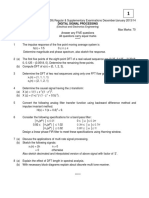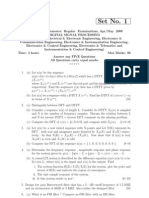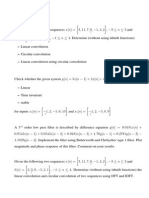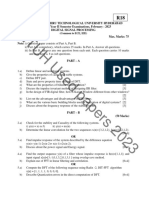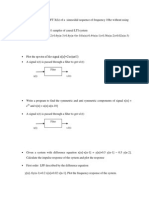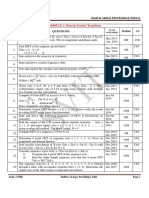ECL352-Digital Signal Processing
Dear Students, practice the following problems
1. Let X(ejω) denote the DTFT of a real sequence x[n].
Show that if x[n] is even, then it can be computed from X(ejω) using [ ] ∫
Try if x[n] is odd.
2. Determine the DTFT of each of the following sequences:
a) [ ] [ ]| | b) [ ] [ ]| |
| |
c) [ ] { d) [ ] {
3. Using Parseval’s theorem, evaluate the following integrals:
a) ∫ b) ∫
4. Let y[n]=x[n]*h[n]. Determine x[n] for the given y[n] and h[n].
y[n]={6,-7,-13, 24, 12, 33, -5, 14} & h[n]={3,4,-1,2}
5. Determine the expressions for the group delay of the following LTI system whose frequency
response is given below:
( ) | | | |
6. Let X(ejω) denote the DTFT of a real sequence x[n]={1,-3,4,-5,7,-5,4,-3,1}
a) For the DFT sequence X1[k] and X2[k]obtained by sampling X(ejω) at uniform intervals π/6 & π/4
starting from ω=0 respectively. Can you recover x1[n] and x2[n] from x[n]
7. The linear convolution of a length-110 sequence with a length-1300 sequence is to be computed
using 128-point DFTs and IDFTs.
Determine the smallest number of DFTs and IDFTs needed to compute the above linear
convolution using overlap-add and overlap-save approaches.
8. Realize the following system function using minimum of multipliers
H(z)= 1+1/3z-1+1/4z-2+1/4z-3+1/3z-4+z-5
9. Obtain the direct form-I, direct form-II, cascade and parallel form realization for the system
[ ]
10. Determine the system function H(z) of the lowest order Chebyshev and Butterworth digital
filter with the following specifications (Use Bilinear Transformation)
a) 3 dB ripple in the passband 0 ≤ ω ≤ 0.2π
b)25 dB attenuation in stop band 0.45π 0 ≤ ω ≤ π
11. Design a finite impulse response (FIR) filter to pass frequencies in the range 0.25 π to 0.75 π
rad/sample using Hamming window, by taking 11 samples of window sequence. Also draw
linear phase structure of the filter






